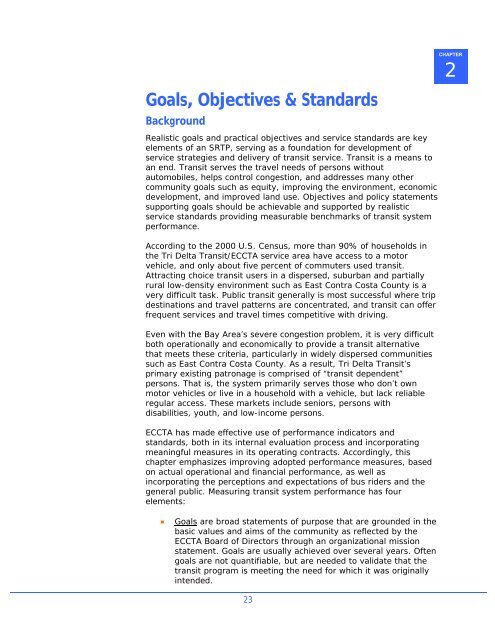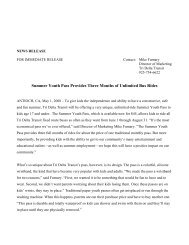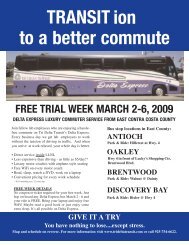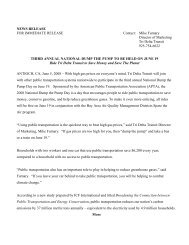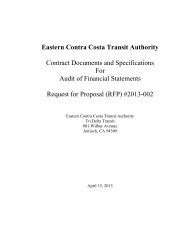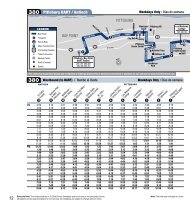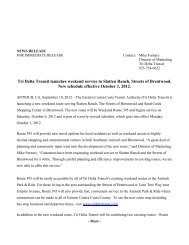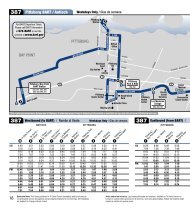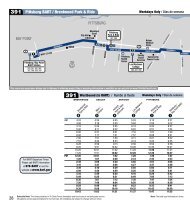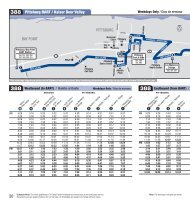to view Short Range Transit Plan FY 2007/2008 - Tri Delta Transit
to view Short Range Transit Plan FY 2007/2008 - Tri Delta Transit
to view Short Range Transit Plan FY 2007/2008 - Tri Delta Transit
You also want an ePaper? Increase the reach of your titles
YUMPU automatically turns print PDFs into web optimized ePapers that Google loves.
Goals, Objectives & StandardsBackgroundRealistic goals and practical objectives and service standards are keyelements of an SRTP, serving as a foundation for development ofservice strategies and delivery of transit service. <strong>Transit</strong> is a means <strong>to</strong>an end. <strong>Transit</strong> serves the travel needs of persons withoutau<strong>to</strong>mobiles, helps control congestion, and addresses many othercommunity goals such as equity, improving the environment, economicdevelopment, and improved land use. Objectives and policy statementssupporting goals should be achievable and supported by realisticservice standards providing measurable benchmarks of transit systemperformance.According <strong>to</strong> the 2000 U.S. Census, more than 90% of households inthe <strong>Tri</strong> <strong>Delta</strong> <strong>Transit</strong>/ECCTA service area have access <strong>to</strong> a mo<strong>to</strong>rvehicle, and only about five percent of commuters used transit.Attracting choice transit users in a dispersed, suburban and partiallyrural low-density environment such as East Contra Costa County is avery difficult task. Public transit generally is most successful where tripdestinations and travel patterns are concentrated, and transit can offerfrequent services and travel times competitive with driving.Even with the Bay Area’s severe congestion problem, it is very difficultboth operationally and economically <strong>to</strong> provide a transit alternativethat meets these criteria, particularly in widely dispersed communitiessuch as East Contra Costa County. As a result, <strong>Tri</strong> <strong>Delta</strong> <strong>Transit</strong>’sprimary existing patronage is comprised of “transit dependent”persons. That is, the system primarily serves those who don’t ownmo<strong>to</strong>r vehicles or live in a household with a vehicle, but lack reliableregular access. These markets include seniors, persons withdisabilities, youth, and low-income persons.ECCTA has made effective use of performance indica<strong>to</strong>rs andstandards, both in its internal evaluation process and incorporatingmeaningful measures in its operating contracts. Accordingly, thischapter emphasizes improving adopted performance measures, basedon actual operational and financial performance, as well asincorporating the perceptions and expectations of bus riders and thegeneral public. Measuring transit system performance has fourelements:• Goals are broad statements of purpose that are grounded in thebasic values and aims of the community as reflected by theECCTA Board of Direc<strong>to</strong>rs through an organizational missionstatement. Goals are usually achieved over several years. Oftengoals are not quantifiable, but are needed <strong>to</strong> validate that thetransit program is meeting the need for which it was originallyintended.23CHAPTER2


